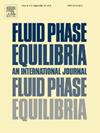Phase equilibrium calculations at low and high pressures with a modified COSMO-SAC model
IF 2.8
3区 工程技术
Q3 CHEMISTRY, PHYSICAL
引用次数: 0
Abstract
This work presents the development of a modified variant of the COSMO-SAC model, aiming to achieve reliable phase equilibrium predictions at both low and high pressures. Two major modifications of the previously published COSMO-SAC models are introduced. First, an improved combinatorial term is used to improve the results in nearly athermal and asymmetric mixtures. Second, a further separation of the hydrogen-bonding sigma profile has been introduced, differentiating the hydroxyl group belonging to water from hydroxyl groups belonging to other compounds, to improve the results in aqueous systems. The model's performance is studied for vapor-liquid equilibrium at low pressures and infinite dilution activity coefficient predictions, and it is benchmarked with respect to COSMO-SAC and COSMO-SAC 2010 models. Furthermore, the model is combined with the Peng Robinson equation of state via the Universal Mixing Rules (UMR) and applied for high pressure vapor-liquid equilibrium predictions. The results indicate that the modified COSMO-SAC model represents a reliable tool for phase-equilibria predictions for systems of various degrees of non-ideality and asymmetry.
利用改进的 COSMO-SAC 模型进行低压和高压下的相平衡计算
这项工作介绍了 COSMO-SAC 模型的改进型,旨在实现低压和高压下可靠的相平衡预测。对之前发表的 COSMO-SAC 模型进行了两大修改。首先,使用了改进的组合项,以改善近热和不对称混合物的结果。其次,引入了氢键西格玛曲线的进一步分离,将属于水的羟基与属于其他化合物的羟基区分开来,以改进水体系中的结果。研究了该模型在低压汽液平衡和无限稀释活性系数预测方面的性能,并以 COSMO-SAC 和 COSMO-SAC 2010 模型为基准进行了比较。此外,该模型还通过通用混合规则(UMR)与彭-罗宾逊状态方程相结合,并应用于高压汽液平衡预测。结果表明,修改后的 COSMO-SAC 模型是预测各种非理想度和非对称性系统相平衡的可靠工具。
本文章由计算机程序翻译,如有差异,请以英文原文为准。
求助全文
约1分钟内获得全文
求助全文
来源期刊

Fluid Phase Equilibria
工程技术-工程:化工
CiteScore
5.30
自引率
15.40%
发文量
223
审稿时长
53 days
期刊介绍:
Fluid Phase Equilibria publishes high-quality papers dealing with experimental, theoretical, and applied research related to equilibrium and transport properties of fluids, solids, and interfaces. Subjects of interest include physical/phase and chemical equilibria; equilibrium and nonequilibrium thermophysical properties; fundamental thermodynamic relations; and stability. The systems central to the journal include pure substances and mixtures of organic and inorganic materials, including polymers, biochemicals, and surfactants with sufficient characterization of composition and purity for the results to be reproduced. Alloys are of interest only when thermodynamic studies are included, purely material studies will not be considered. In all cases, authors are expected to provide physical or chemical interpretations of the results.
Experimental research can include measurements under all conditions of temperature, pressure, and composition, including critical and supercritical. Measurements are to be associated with systems and conditions of fundamental or applied interest, and may not be only a collection of routine data, such as physical property or solubility measurements at limited pressures and temperatures close to ambient, or surfactant studies focussed strictly on micellisation or micelle structure. Papers reporting common data must be accompanied by new physical insights and/or contemporary or new theory or techniques.
 求助内容:
求助内容: 应助结果提醒方式:
应助结果提醒方式:


